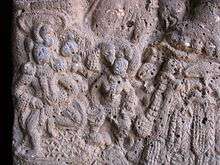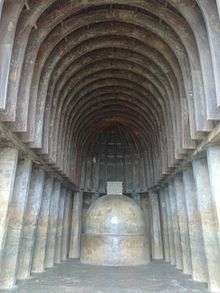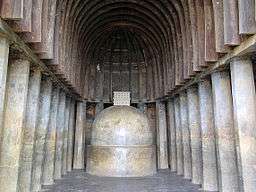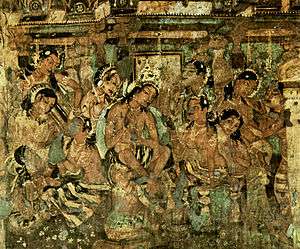Bhaja Caves
| Bhaje Caves | |
|---|---|
|
Stupa in the Chaityagrha, Cave XII | |
| Location | Bhaja,[1] Maharashtra, India |
| Coordinates | 18°43′40″N 73°28′55″E / 18.72778°N 73.48194°ECoordinates: 18°43′40″N 73°28′55″E / 18.72778°N 73.48194°E |
| Geology | Basalt |
| Entrances | 22 |
| Difficulty | easy |
| Pronunciation | [Bhaja or Bhaje] |
| Pilgrimage to |
| Buddha's Holy Sites |
|---|
 |
| The Four Main Sites |
| Four Additional Sites |
| Other Sites |
| Later Sites |
Bhaja Caves or Bhaje caves (Marathi: भाजा) is a group of 22[2] rock-cut caves dating back to the 2nd century BC located in Pune, near Lonavala, Maharashtra. The caves are 400 feet above the village of Bhaja,[3] on an important ancient trade route running from the Arabian Sea eastward into the Deccan Plateau (the division between North India and South India).[4] The inscriptions and the cave temple are protected as a National Monument, by the Archaeological Survey of India per Notification No. 2407-A.[5][6] It belongs to the Hinayana Buddhism sect in Maharashtra.[2] The caves have a number of stupas, one of their significant features. The most prominent excavation is its chaityagrha (Cave XII), demonstrating prototypes of wooden architecture and a vaulted horseshoe ceiling. Its vihara (Cave XVIII) has a pillared verandah in front and is adorned with unique reliefs.[7] These caves are notable for their indications of the awareness of wooden architecture.[2] The carvings prove that tabla – a percussion instrument – was used in India for at least two thousand years. The carving shows a woman playing tabla and another woman, performing dance.
Architecture

The Bhaja Caves share architectural design with the Karla Caves. The most impressive monument is the large shrine — chaityagriha — with an open, horseshoe-arched entrance; according to the Archaeological Survey of India, the chaityagrha is the most prominent aspect of the caves, and one of the earliest of the type.[2] The chaitrya has unique reliefs from Indian mythology. Other caves have a nave and aisle, with an apse containing a solid tupa and the aisle circling round the apse, providing the circumambulation path.[8]
Chaitygraha has some Buddha images. A cistern inscription shows the name of a donor, Maharathi Kosikiputa Vihnudata, from the 2nd century AD. A wooden beam records two more inscriptions datable to 2nd century B.C., which indicates caves have been there for at least 2200 years.[2] Eight inscriptions are found in the caves, some giving the name of the donors.[7]
The sculptures feature elaborate headdress, garlands, and jewellery; they might have originally been painted in bright colors but later covered with plaster. Characteristic for early Buddhism, initially the caves had symbolic Buddha representation. After 4 A.D. Buddha was painted in physical form as well.[9]
Near the last cave is a waterfall which, during the monsoon season, has water that falls into a small pool at the bottom.[10] These caves also provide important proof regarding the history of the Tabla, an Indian percussion instrument, since carvings from 200 BCE show a woman playing tabla and another performing a dance.
Stupas

A notable part of the monument is a group of 14 stupas, five inside and nine outside an irregular excavation. The stupas are relics of resident monks, who died at Bhaja, and display an inscription with the names of three monks, Ampinika, Dhammagiri and Sanghdina.[7] One of the stupa shows Stavirana Bhadanta means the venerable reverend inscribed on it.[11] The stupa particulars show the name of the monks and their respective titles.[12] The stupas have been carved very elaborately and two of them have a relic box on their upper side. Names of monks have been titled with Theras.[1]
Caves
- Cave VI
It is irregular vihara, 14 feet square, has two cells on each side and three on back side. The chaitya window is ornamental all over cell doors.[1] ploughman’s wife, Bodhi, gifted this Vihara as her name is inscribed on cell door.[11]
- Cave IX
Rail pattern ornament, broken animal figures, verandah is on frontal side. It is similar to Cave VIII at Pandavleni Caves.[1]
- Cave XII
Chaitya is 26 feet 8 inches wide and 59 feet long, with semi-circular apse at back, and having aisle 3 feet 5 inches wide, separated from the nave by 27 octagonal shaft. 11 feet 4 inches height. The dogoba is 11 feet diameter at the floor. This resembles the Kondana Caves. The pillar has 7 different symbols of Buddha shown in floral form, buds, leaves, fan.[1]
- Cave XIII
This seems to be destroyed may be it would have been wood architect during ancient times. It is 30 feet long and 14.5 feet deep. Rail pattern is observed, a few cells at the back and a bolt door system are observed here.[1]
- Cave XIV
This cave is facing towards northern side 6 feet 8 inches wide and 25.5 feet deep, with 7 cells. Stone benches, square windows, stone beds—are observed in the cells.[1]
- Cave XV
It can be reached by stairs to the south of Cave XIV. It is a small vihara 12.5 wide and 10 feet deep. It has two semi-circular niches and a bench on right side.[1]
- Cave XVI
This façade has 3 Chaitya arches and the rail pattern.[1]
- Cave XVII
It is a small vihara 18.5 feet long and 12.5 deep, with 5 cells, one of the cell has a bench in it. It has two inscriptions in it one of which is damaged.[1] Cell door inscription describes “the gift of cell from Nadasava, a Naya of Bhogwati.” [11] One more inscription over two wells in one recess describes “a religious gift of cistern by Vinhudata, son of Kosiki, a great warrior.” [11]
- Cave XIX
It is a monastery with a verandah. The door has guardian figures on both sides. This cave has Surya riding a chariot and Indra riding on an elephant.[13]
 Stairways to Bhaja Caves
Stairways to Bhaja Caves Chaityagruha at Bhaja Caves
Chaityagruha at Bhaja Caves Wooden Ceiling in Main Chaitygruha
Wooden Ceiling in Main Chaitygruha Carvings at Bhaja Caves
Carvings at Bhaja Caves Bhaja Caves
Bhaja Caves Carvings at Bhaja Caves
Carvings at Bhaja Caves Carvings at Bhaja Caves
Carvings at Bhaja Caves Waterfall at Bhaja Caves
Waterfall at Bhaja Caves Significant Part of Bhaja caves
Significant Part of Bhaja caves Facade of the caves
Facade of the caves Starways to Bhaja Caves
Starways to Bhaja Caves Panorama Bhaja Caves
Panorama Bhaja Caves
References
- 1 2 3 4 5 6 7 8 9 10 Burgess, James (1880). "The caves in vicinity os Karle and the Bor Ghat". The Cave Temples of India. W.H. Allen. pp. 223–228. Retrieved 5 July 2013.
- 1 2 3 4 5 "Ticketed Monuments - Maharashtra Bhaja Caves, Bhaja". Archaeological Survey of India, Government of India. Retrieved 5 July 2013.
- ↑ "CHAPTER 20 PLACES OF INTEREST". Maharashtra Government - Tourism and Cultural Dept. Retrieved 6 July 2013.
- ↑ "Later Andhra Period India". Retrieved 2007-01-24.
- ↑ "List of the protected monuments of Mumbai Circle district-wise" (PDF).
- ↑ "Bhaja Caves Visitors' Sign". Retrieved 2012-10-08.
- 1 2 3 Ahir, D. C. (2003). Buddhist sites and shrines in India: history, art, and architecture (1. ed.). Delhi: Sri Satguru Publ. p. 191. ISBN 8170307740.
- ↑ "5000 Years of Indian Architecture". Archived from the original on 14 April 2007. Retrieved 2007-03-14.
- ↑ Behl, Benoy K (Sep 22 – Oct 5, 2007). "Grandeur in caves". Frontline. 24 (19). Retrieved 6 July 2013.
- ↑ "Karla & Bhaja Caves: High-Water Mark of Buddhist Architecture". India Travelite. Retrieved 6 July 2013.
- 1 2 3 4 Burgess, James; Indrājī Bhagvānlal (1881). "Bhaja Caves and their inscriptions". Inscriptions from the Cave-temples of Western India: With Descriptive Notes &c Volume 10 of Archæological Survey of Western India. Government Central Press. pp. 22–25. Retrieved 6 July 2013.
- ↑ Schopen, Gregory (1996). Bones, stones and Buddhist monks : collected papers on the archaeology, epigraphy, and texts of monastic Buddhism in India. Honolulu: University of Hawaii Press. p. 175. ISBN 0824818709.
- ↑ Knapp, Stephen (2009). "Karla and Bhaja Caves". Spiritual India handbook : a guide to temples, holy sites[,] festivals and traditions. Mumbai: Jaico Publishing. ISBN 8184950241. Retrieved 6 July 2013.
External links
![]() Media related to Bhaja Caves at Wikimedia Commons
Media related to Bhaja Caves at Wikimedia Commons



